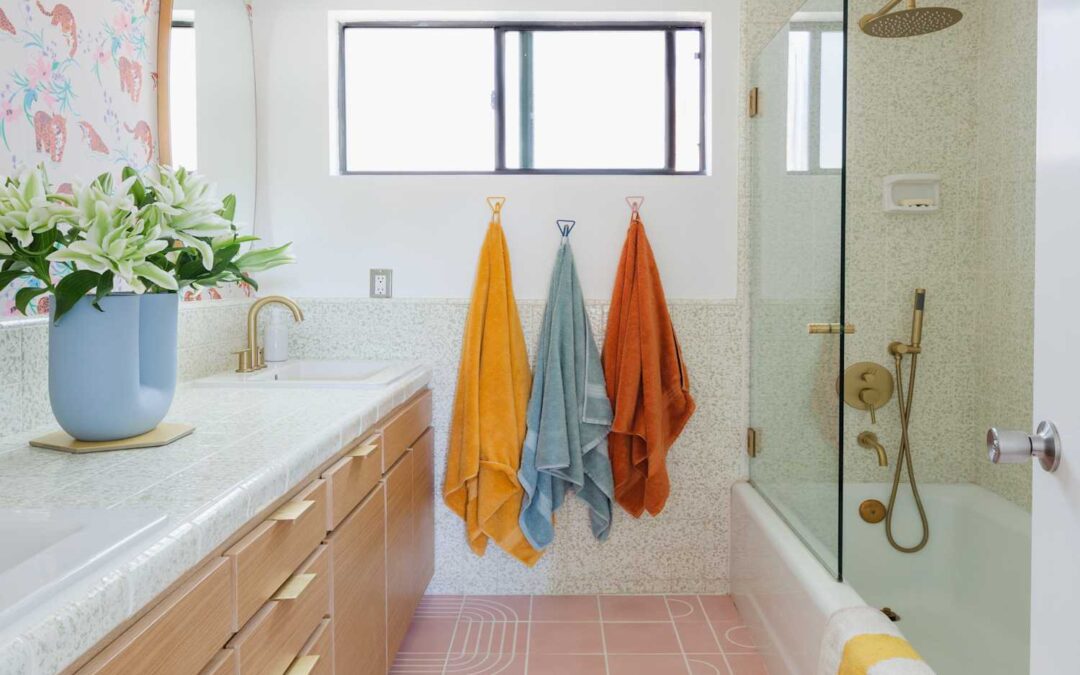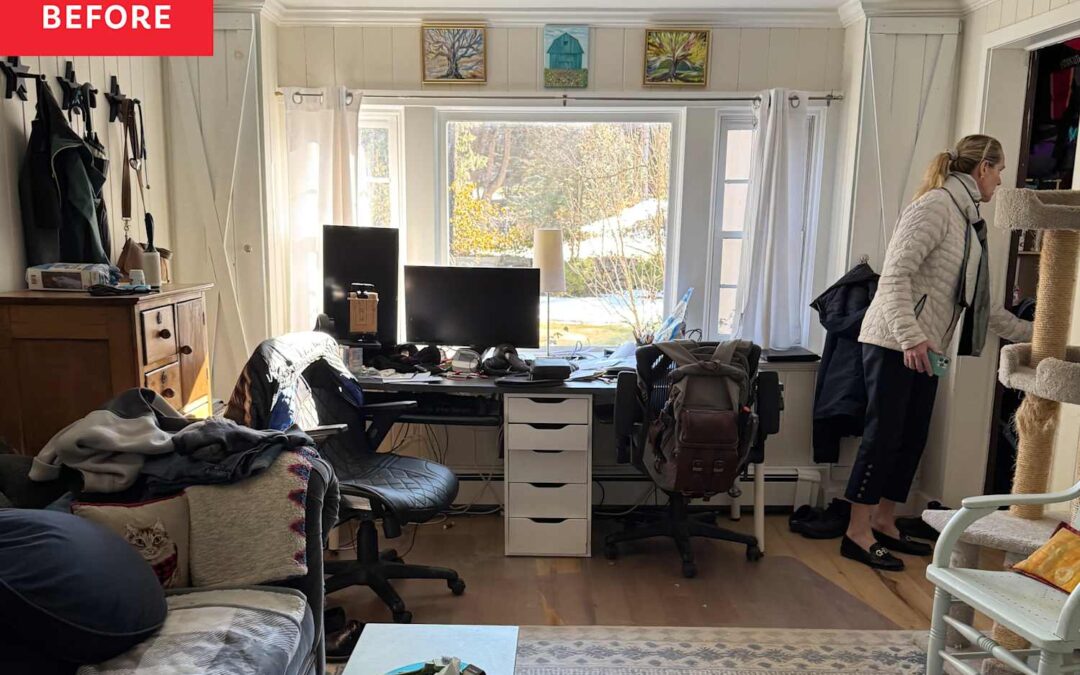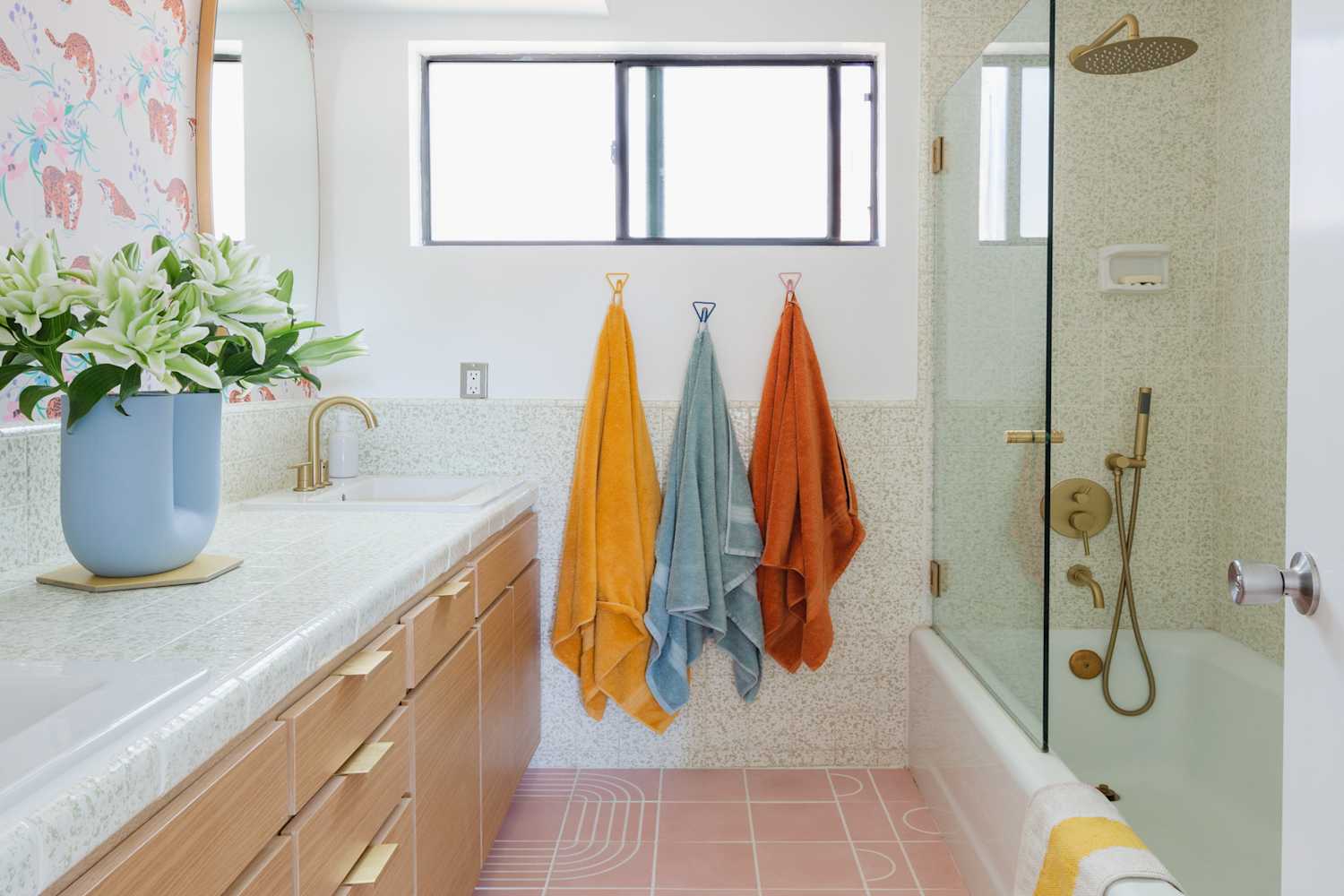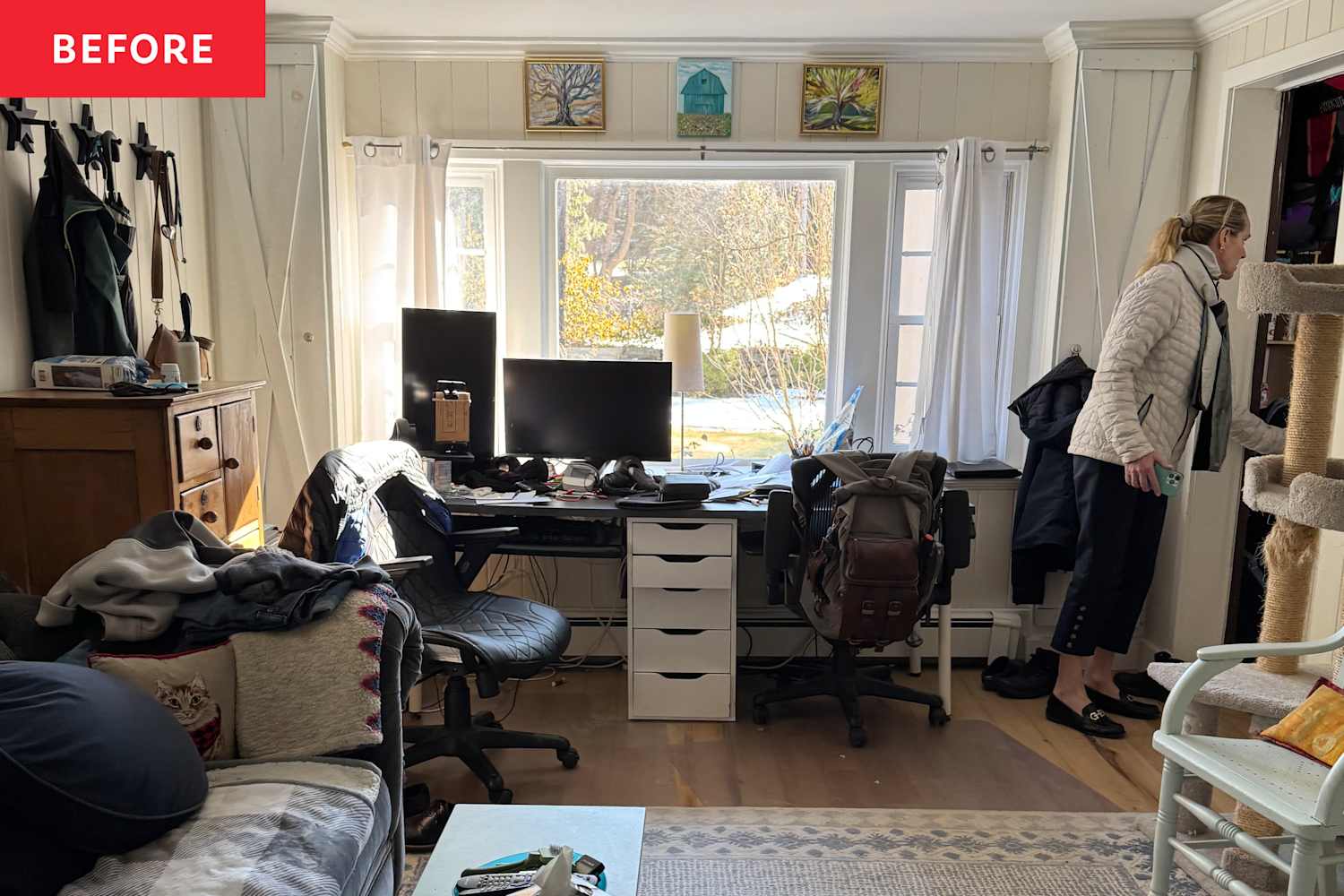
by Furnishly | Sep 5, 2025 | Design Inspiration, Style

Almost two years ago, my husband and I bought our dream home on the Gold Coast of Queensland, Australia: a 1980s brick house with three bedrooms, two baths, and 2,900-square-foot space. It has all the hallmarks of the era it came from — single-glazed windows, gaps that leaked air, gas appliances, and no insulation in the ceiling or internal walls — but we fell in love with it at first viewing.
READ MORE…

by Furnishly | Sep 5, 2025 | Design Inspiration, Style
We
independently select these products—if you buy from one of our links, we may earn a commission. All prices were accurate at the time of publishing.
Sometimes, older buildings that have been converted into condos or apartments can be oddly shaped and sized. That was the case with this particular Madison, Wisconsin, condo located in Capitol Square. The one-bedroom, one-bath residence featured a generous living, dining, and kitchen area — but also featured a tucked-away, highly angular bonus room that offered a unique challenge in regard to furniture configuration.
“The previous owners had a dining space in there,” explains Chris Bailey, the staging coordinator at The Cozy Home, the company hired to work on this project. “The photos from a previous listing showed a workspace in there, but it wasn’t scaled properly. There was a large desk you had to scooch around.”
When it comes to staging, the goal is to help people see themselves living in the space, which is especially useful with one that’s oddly shaped. Here’s how the pros made the space more functional, and helped the home sell as a result.
They anchored the oddly-shaped space.
When working with a tight and oddly shaped space such as this office, it’s important to consider scale. The size of the furniture will considerably impact how the space appears as well as how it functions. A too-big desk can be a nuisance to have to navigate every day, and furnishing the space efficiently can allow for maximum usable space. “If you put too much or too-big furniture, it becomes less functional,” the stager says.
The designer and her team went about focusing on anchoring the room. In interior decorating, anchor pieces are typically larger and offer a visual focal point that your eyes are drawn to when first looking at the room.
Anchoring is particularly important in open-concept spaces where the bounds of the living room, dining room, or, in this case, the office may be fluid or expandable. To achieve this, The Cozy Home put down an appropriately sized rug to ground the workspace.
They created a reading nook.
But the stagers didn’t just stop at the workspace. They were even able to make this bonus room somewhat multifunctional by adding a chair in the corner to create a reading nook that sort of floats behind the desk.
“A chair works well in that nook in the corner because it’s an acute angle,” Bailey says. “In this space, you’re using that acute corner for the small nook because it sits there and then you can use the open space for the table. You can fit more than if you were to flip it.”
Those working with a similar space might consider embracing those tight corners or small nooks within their home to create a functional retreat, such as a reading nook, or something visually interesting.
“When you have an oddly shaped room, take those acute angles and look for opportunities or a design moment,” Bailey suggests. “Maybe instead of a reading nook it’s a tall plant or lamp; or use that space because it’s inherently cozy for some smaller niche.”
The condo was on the market for $324,000 and is currently under contract.
“Stagers have to work with what’s there,” Bailey says. “We create privacy where there is none and anchor spaces. A lot of open floor plan homes are not well-thought-out and it can be very difficult to create a cozy space. We achieve this with rugs, scale, and lighting.”

by Furnishly | Sep 3, 2025 | Design Inspiration, Style
We
independently select these products—if you buy from one of our links, we may earn a commission. All prices were accurate at the time of publishing.
I’ve been thinking about Heidi Gardner a lot lately. The Saturday Night Live alum just announced she’d be stepping down ahead of the show’s 51st season, and while I’m so sad I won’t see her on my screen every Saturday night, I’m more curious to know if I’ll ever be able to get more glimpses of her absolutely astounding mid-century modern home in Kansas City, Missouri.
Gardner opened up her home to Architectural Digest, and I’m genuinely obsessed with it. “This house is both a Kansas City labor of love and a New York labor of love, which is kind of like me, my two favorite places in the world,” Gardner said in the YouTube video. For the design build, she worked with Cicada Company in Kansas City, and for the interior design, she chose the New York-based Madeline Hudson Interiors.
“It was really important to me to keep the vibes that I originally saw when I walked in this house with the wood walls and the stone,” Gardner says. “I was like, ‘I’m in the Boogie Nights house.’” (This is one of my all-time favorite movies, and she is spot-on with the reference.)
Why Heidi Gardner’s MCM Home Is a True Gem
It is both my opinion and the pro opinion that all new owners of MCM homes should approach renovation with the idea of keeping those OG vibes, says Ashley Kendrick of Ashley Kendrick Real Estate in Kansas City. “[An MCM home] is a piece of art; it’s an artifact,” she explains. “And I think knowing what belongs in that house to preserve is key.”
MCM homes are “the emotional buy here,” especially when they are redone well. “There’s a limited supply of them in Kansas City, so you get a lot of people willing to pay, I would say, more than market value.” Kendrick says that MCM homes in the Kansas City area can range from $400,000 to upwards of several million dollars.
There’s a good reason that homebuyers are willing to stretch their budgets for MCM homes. “Architecturally, they’re their own animal,” Kendrick says. She notes the wood and stone elements give these homes a “warm Japanese feel.” She cites Don Drummond as one of the key architects who brought MCM to Kansas City; Bob Wendt, David Runnels, and Bruce Goff are among other noted MCM pioneers in the area.
Unless an MCM home has been recently updated, buyers can expect to pay more — sometimes a lot more — for energy-efficient enhancements. Andrew Bash of Sage Sotheby’s International in Kansas City says that the original homes were constructed with single-pane windows. And because MCM homes have no lack of natural light pouring in, it’s a hefty investment to replace the many windows and glass doors.
But don’t dare call an MCM a money pit. “I would liken them to a really nice, amazing sports car that you’re going to probably have to tweak to keep running, as opposed to it just being super efficient right out of the gate,” Bash says.
The Features I’m Most Obsessed with in Gardner’s MCM Home
My favorite things about the home? The over-the-top touches (her disco-ball range hood is beyond cool) and how much original features were preserved. Gardner and her design teams kept much of the wood accents in the home, including the wood paneled walls.
Some might want to tear down wood panel walls in just about any other type of home, but in an MCM home, you’ll actually want more of them. In fact, most of the walls in the home feature light wood, with two notable exceptions: the gorgeous stone fireplace and an office/media room decorated in Gucci wallpaper. “It’s not reasonably priced,” Gardner admits, although she is thrilled with her splurge.
Gardner actually calls this wallpapered room a “snug,” which is a new-to-me term. But I got the vibe as soon as I saw it. It’s a luxurious yet comfortable retreat where she can write, hang with her cats — seriously, she also splurged on the most incredible cat tree you’ll ever see — and even host tailgating parties. (She’s a huge Chiefs and Royals fan.) There are two glass doors that open to the outside, offering easy access to the barbecue and smoker on game days.
If you saw Gardner’s incredible backyard and pool without knowing that she lived in Kansas City, it would be very easy to assume she purchased a home in Palm Springs. It’s amazing to see that it’s possible to blend a coastal vibe into the Midwest. But indoor/outdoor living is one of the hallmarks of MCM homes, no matter the location, although the Kansas City climate allows plenty of time to enjoy it. “[The weather] is amazing from March through November,” Kendrick says.
Many Kansas City homes have pools, some of which were added during the COVID-19 pandemic, when many people relocated back to the area, according to Kendrick. Unlike other geographical areas where pools might detract value from the home, pools add value to Kansas City homes, especially with that extended swim season.
As much as I adore my Cape Cod-style house, my new goal in life is to own an MCM home. And while I’m sad to see that Gardner won’t be returning for Season 51 of Saturday Night Live, I can’t help but be glad that it’s a great opportunity for her to spend more time in her glorious new digs.

by Furnishly | Sep 2, 2025 | Design Inspiration, Style
We
independently select these products—if you buy from one of our links, we may earn a commission. All prices were accurate at the time of publishing.
Conventional wisdom says you should feel free to decorate and remodel your home as you like. But at the same time, it also says that if you plan to sell your place at some point, you’ll want to make sure it appeals to the majority of homebuyers. The landlord special can be painted over. You can always remove the wallpaper. But remodeling is where it gets tricky. It’s expensive, extensive, and you want to make sure that the changes you make correspond with increasing value in your home.
Bathroom remodeling is a high investment project that can come with a high reward. After all, if a buyer looks at your bathroom and sees something in serious need of repair, they may want to walk away and find something a bit more turnkey. But knowing what to renovate, get rid of, and replace altogether can be challenging, and I’ve been confused by multiple reports that say that bathtubs are out — and people are replacing them with spa-like shower solutions. So I reached out to professionals — and got a clear answer.
Are Bathtubs Disappearing?
I was a kid during the era of the “Calgon, take me away!” bath product commercials. If you don’t know what I’m talking about, here’s the gist: A frazzled mom standing in a chaotic household would utter the phrase and be immediately transported to a luxurious bubble bath, where her troubles would simply soak away. That commercial has stuck with me over the years (ugh, I mean decades), but as much as I love a bubble bath, I can count the number of times I have actually filled our bathtub on one hand.
It’s not just a Northeast thing, either. “In Miami Beach, buyers don’t care much about outdated bathtubs you still see in some homes,” says Laura Barrera, luxury real estate advisor at Douglas Elliman David Siddons Group in Miami Beach, Florida. “I’ve shown properties to clients where the reaction was basically, ‘Why is this still here?’”
And multiple reports — like Angi’s 2024 State of Home Spending Report — have found that homeowners are planning on getting rid of their bathtubs for large, groutless showers, like the type you’d see at a nice hotel. Another 2025 report from Zillow found that folks were working to replace their bathtub shower combo with “wet rooms,” a luxurious, spa-like shower space that has a bathtub in the corner, so you can shower freely, without worrying about stepping in and out of the tub.
But that doesn’t mean you should rip out your tub. There are important home value adds to consider.
The One Time You Shouldn’t Get Rid of Your Bathtub
Even though it’s important to consider what potential homebuyers want, homeowners should pause before letting this shift in consumer sentiment convince them to ditch the tub. “You can, in fact, make a pretty compelling argument [that] depending on the type of property you have, you could be shooting yourself in the foot,” Beauchamp says.
For example, if you live in a studio apartment, a space that would most likely be home to a single person or two people at most if you ever move out, it would make sense to swap out your bathtub for something with a smaller footprint. Your assumption would reasonably be that the next occupants would be a single person or a couple without children. Or at least, no human children. But even then, think twice — Beauchamp says that pet owners often like having a tub to wash their fur children.
My husband and I live in a small two-bedroom Cape Cod located in a great school district near a beautiful park. The chances are high that a small family will buy our home — especially since we have two bathrooms, one with a tub and one with a shower, an anomaly for a home our size. For this reason, we wouldn’t think of removing the one bathtub we have. And if we had just the one bathroom, we wouldn’t even be having the tub/no tub conversation.
“If it is a property that conceivably could house some configuration of a family, they’re always going to want a bathtub,” Beauchamp says. Personal preferences are important, but it’s helpful to think of who the buyer pool might be when it’s time to sell, she explains.
This is not to say, of course, that a single person or an older couple looking to downsize wouldn’t be interested in buying our home. But were we to get rid of the tub, we are essentially saying goodbye to a large portion of buyers, Beauchamp says. And it’s important to note that having a walk-in shower is really important from an accessibility standpoint — yes, you can keep the tub, but ensuring that someone with different mobility needs can easily get in and out of the shower is also very important.
With inflation on the rise and mortgage rates not budging (as yet), Beauchamp says that many would-be homebuyers are staying put for now. That means sellers have to make the most of the buyers who are active. “In a market that already has challenges, why would you want to cut off a potential portion of your buyer pool?” she says.
Should You Get Rid of Your Bathtub?
All in all: It depends. If you have multiple bathrooms with bathtubs, you might want to consider swapping one out for a large, walk-in, spa-like shower, for accessibility needs and to appeal to a wide array of buyers. If you live in a property that might not attract families, you can also consider getting rid of your tub.
If you have a small bathroom that seems overpowered by a tub, you might consider making the switch to a shower.
Provided a bathroom renovation includes an accessible shower with a sleek, spa-like aesthetic — think flush entry and double showerheads — homeowners won’t be reducing the value of their property, even if it’s the only bath. “A new shower always makes more of an impact than keeping an old tub,” Barrera explains. But if you like your bathtub, use it, and if you see no use in getting rid of it, then don’t.
Beauchamp notes that kitchen and bath remodels are among the most expensive projects for homeowners. And if you’ve redone a bathroom already, it might be enough for buyers to ditch their “Calgon, take me away!” daydreams. “No one wants to rip apart a perfectly beautiful bathroom to put in a bathtub,” Beauchamp says.

by Furnishly | Aug 29, 2025 | Design Inspiration, Style
We
independently select these products—if you buy from one of our links, we may earn a commission. All prices were accurate at the time of publishing.
Realtor Fiona Dogan is a big believer in the power of home staging, and she knows what she’s talking about. As an agent in the top 3% at Julia B. Fee Sotheby’s International Realty in Rye, New York, Dogan understands what it takes to take homes from sitting on the market to flying off the “shelves.” She put her expertise to use when selling a 1920s Tudor home that originally “felt dark and dated” with its low ceilings, small and oddly shaped rooms, and small and dated kitchen.
In general, Dogan’s belief system is as follows: “Decluttering, refreshing, and staging a house are critical to a successful real estate transaction in this current market. When my clients invest $30,000 to $50,000 in preparing their house according to my recommendations, the payoff is big. We typically will sell for $200,000 to $300,000 over the asking price!” Here’s how she transformed the space — and got the sellers a major return on investment.
The Power of Staging Even Before Entering the Home
“In today’s market, photography and an online presence are critical,” says Dogan. “Buyers shop 24/7 online, and if the house does not look dazzling when you see it online, most buyers just move on.” Dogan uses this knowledge to make houses appealing in buyers’ first contact with the home, which is almost always digital.
“My staging principle is to make every property HGTV-ready so it stops a buyer in their tracks, entices them to make an appointment to see the house, and feel wowed as they step inside and walk around,” she adds.
Ensuring the staging makes the home look stunning in photos, before anyone ever sets foot in the house, primes potential buyers for a positive reaction and kickstarts the emotional attachment to a space that’s critical for people to buy.
Big and Small Changes Add Up to Major Impact
In order to make this particular home appealing from the first look online through an actual physical walk-through, Dogan set out to “brighten it, give the rooms meaning and purpose, and modernize the decor and furnishings.”
Specifically, she began by painting the entire first floor Benjamin Moore’s White Dove because, as she put it, “first impressions are critical.” The white paint acted as a fresh canvas for the rest of the changes.
Dogan repurposed some of the rooms so that buyers could better imagine themselves living in the space. She and her team converted the office into the dining room, and then the former dining room became the family room, the the former family room transitioned into a formal living room. The downstairs gym was refreshed as a recreation room, and then the small upstairs bedroom was converted into an office.
Lastly, Dogan and her team “updated the decor with modern light fixtures, and staged all the rooms with contemporary white sofas, chairs, tables, rugs, lamps, and white bedding.” Additionally, they took up old carpet in order to “showcase the beautiful hardwood floors that buyers covet.”
The result of these changes, Dogan shares, was that “the house looked refreshed, modern, and move-in ready. Buyers just need to bring their toothbrush!”
The effect of home staging is evident in how quickly a home sells and for how much.
This was exactly the case with this beautifully refreshed Tudor. “The transformation made all the difference,” declares Dogan, detailing that “the house had 25-plus showings and sold at the very aggressive asking price after multiple bids.”
“If the house was not prepared well, I estimate it might have sold [for] $200,000 [or] $300,000 below asking,” she adds. Now, that’s a good return on investment!










